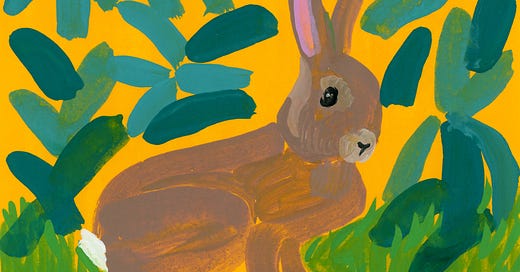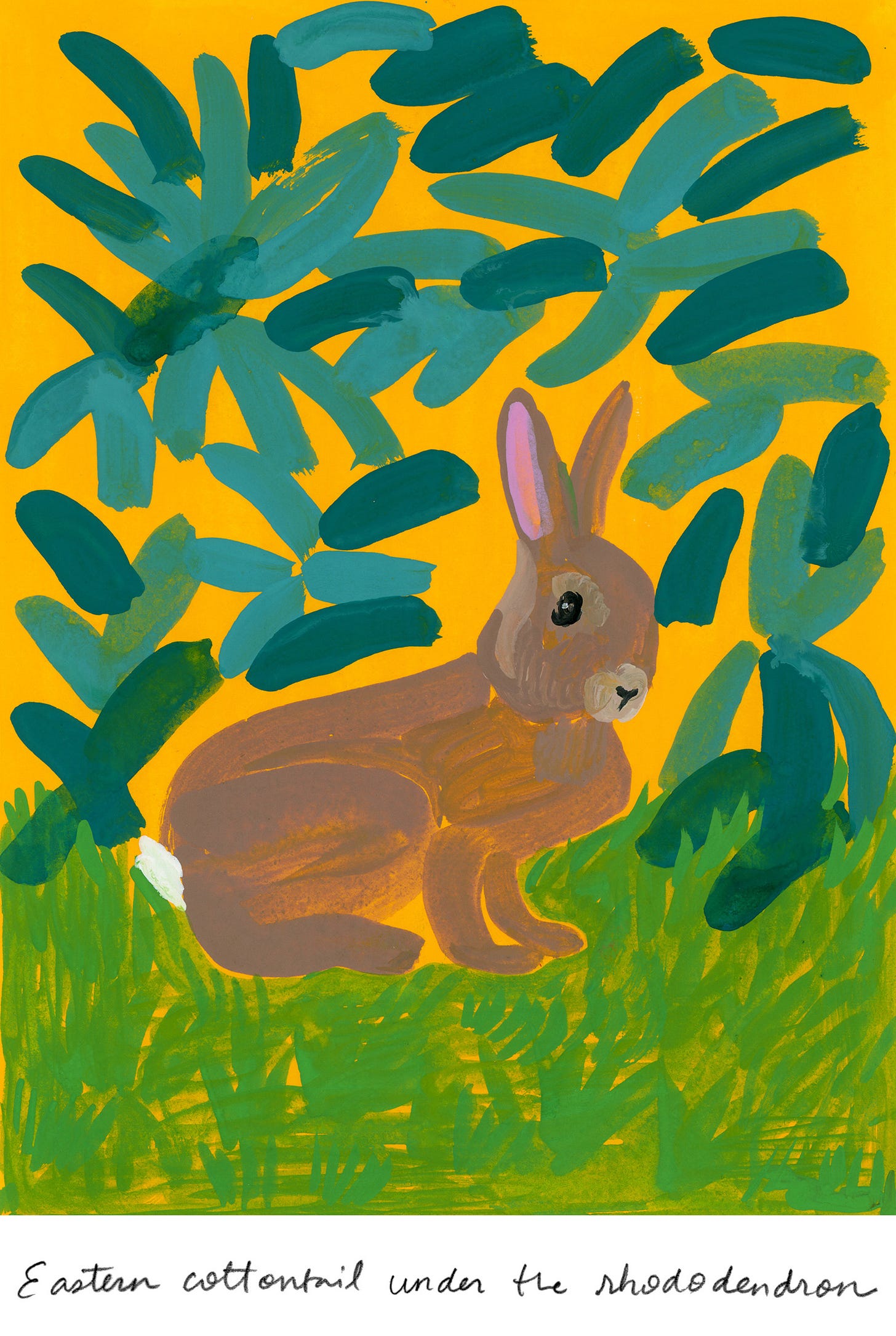Hi, friends — last summer the bunnies (Sylvilagus floridanus) appeared out of nowhere. Did they know how much we needed them? Is it possible to put yourself in a bunny’s shoes (paws) and leap into the understory? Let’s give it a try. As always, you can reply directly to this email or leave a comment, I’d love to hear your stories. — Amy Jean
The other morning I woke up around dawn and looked out the kitchen window. A thick fog had settled down to the ground. The forsythia and daffodils were ablaze, bouncing their yellow light through the gray, but the sun was nowhere to be found, refracted out of existence. I like looking out windows (kitchen windows in particular); it is one of my favorite things to do. In this dreamy moment, poised above the sink, I saw the first bunny of the year flash into view.
I want this to be a scene in a movie (tired woman, dirty dishes, mystical morning, bunny). A few moments later, another bunny came blazing through, from a slightly different angle, heading in a slightly different direction. If this were a movie, the bunnies would continue to bound across the yard at a regular pace. I always wonder if I’m meant to follow. If this were a movie, I’m sure I would.
Eastern cottontails do not hibernate, and I’ve been wondering if they made it through the winter. I needn’t have worried, but all the same it was a delight to see them. Eastern cottontails are the most common rabbit species in North America, native to some regions but introduced to the Northeast in the late nineteenth century (for hunting purposes). They are more adaptable than the New England cottontail, whose numbers have suffered from the loss of thickets and young forests.
Cottontails are active during the day, but prefer the evening and cover of gray weather (predators are many: hawks, raccoons, owls, snakes, crows, skunks, coyotes, bobcats, dogs, cats, people). They are prolific, as common wisdom goes. A doe may have four litters of around five bunnies a year. She makes a shallow, fur-lined nest to give birth and practices a kind of benign neglect, leaving the babies for long stretches, coming back only to nurse. These little nests of half-abandoned bunnies are often in the middle of yards, so be careful with that first mow of the year, and don’t worry if you don’t see the mother, she is nearby and watching.
Eastern cottontails are fast, clocking in around 18 miles/hour. They run in a zigzag pattern with tails bobbing. I find it fascinating to watch them try to fold their long back legs under their bodies as they forage; they aren’t really designed for a casual stroll. Cottontails eat all manner of green things and are strictly vegetarian. In order to get all of the nutrients from fibrous plants, they eat their own soft, green droppings.
It’s not easy being a bunny (beyond eating your own feces). Most descriptions of them talk about how important they are as a prey species; mortality is about 80% each year. While true, this seems unfair. Eastern cottontails have adapted as well as possible to evade their predators, with big, keen eyes and ears. They do their best, they have their moments; they survive.
Somehow this formula has made them particularly charismatic to us. For me, they are forever the stars of an enigmatic movie happening daily outside my window.
Next time I will follow.
Eastern cottontail links—
Take 2 mins. to watch a bunny nibble some greens and then stretch, gently, peacefully, while crickets chirp [YouTube]
This footage of a bunny running in slow motion is fairly mesmerizing; leave the sound off [YouTube]
Not Eastern cottontails, but related—here’s a great introduction to the mercurial swamp bunny (very cool, very good swimmers) [PBS via YouTube]
This is a long one from 1955 (like an old filmstrip I suppose) by the Missouri Conservation Commission. It features some pretty crazy footage (gray fox in a tree hunting a frog; weasel in a log; hawk moth; a coyote chasing/catching a bunny; a king snake eating a litter; baby bunnies foraging; baby bunnies drowning in a flood; a boy shooting a bunny; men and machines destroying habitats; men and dogs hunting rabbits). Someone could write a thesis on it. The musical score is dramatic and occasionally features a lovely clarinet. [via YouTube]
Speaking of movies—
I watched Kumiko, The Treasure Hunter sometime last year and it’s beautiful and sad in a way that sticks. Bunzo the bunny is an important character who has stayed with me.
Thanks to David for sending this stop-motion film from 1930 “Le Roman de Renard” by Ladislaw Starevich (in French with English subtitles). Rabbits feature as one of the many animals fed up with the fox’s ways. It is intense, not light-hearted. A choir bunny is accused of getting drunk on communion wine. The animation is incredible. [via YouTube]
Animal encounters in recent comments—
A lovely picture described by Wyatt of bats along the San Francisco coast as the sun sets. And a terrific, surreal adventure with bats in an Italian swimming pool, with thanks to Emily. Read about them here.
Also—
Flowers for sale! I’ve updated my sale site with drawings from Florapedia, starting at $85. Handkerchief trees and bee orchids, among many others. They would make a sweet present. Please email with any questions (shipping outside of the US, for example—I can make this happen).
Next time: who are my snake friends? I saw a garter snake the other day; it stared at me and then slipped down a hole in the grass. They are strange, the serpents.
I may be shifting this newsletter to a biweekly format so that it can be sustainable for all. Any suggestions please let me know. In the meantime, here are more bunnies of mine from a few years ago, at the Poetry Society of America.
Wild Life #21 / This newsletter is a small weekly adventure about the life around us. Thanks so much for reading and sharing with friends and family.






I really enjoyed the inclusion of the sketches at the bottom. Your paintings are always lovely, but the gestural linework and motion in these sketches shows a different side — you are a keen observer with a deft hand.
Your blog is SO lovely!